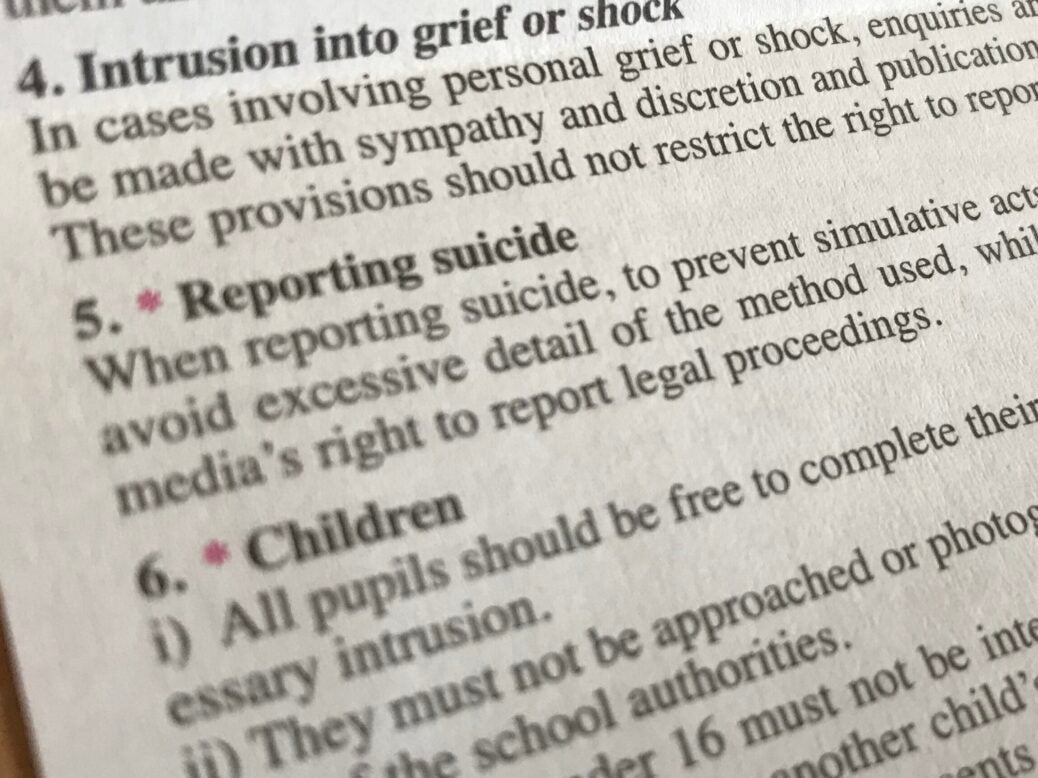
The UK’s largest press regulator has issued new guidance on the reporting of suicides, urging reporters and editors to avoid “overly detailed” descriptions of methods used.
The Independent Press Standards Organisation said there was a “wide body of research evidence” showing that media descriptions of suicide could influence copycat suicide attempts, particularly by younger people.
“The research shows that overly detailed reporting does not just influence the choice of method of a suicide, but can lead to additional deaths which would otherwise not have occurred,” IPSO wrote.
The regulator pointed to research in Taiwan that found media reports of suicides involving charcoal led increased the number of people attempting to kill themselves with the substance the next day.
IPSO’s new guidance offers advice on how the Editor’s Code of Practice, the standards to which all of its members are held, applies to the reporting of suicide. It was produced in partnership with suicide prevention organisation Samaritans and PAPYRUS Prevention of Young Suicide.
It includes information on the risks of reporting suicide, how to do so sensitively and what counts as excessive detail in reports.
Clause 5 of the Editors’ Code already sets out that “care should be taken to avoid excessive detail of the method used”.
The new advice expands on this, saying: “In order to decide if a detail is excessive, you should consider whether it is necessary to explain the events you are reporting.
“Also consider whether the detail could help someone to take their own life. It may be relevant to report that an individual died by hanging, but including details of the ligature or point of suspension is likely to be considered excessive.”
Further examples of excessive detail in suicide reports include:
- the number of pills taken in overdose cases
- steps taken by a person to poison themselves
- the positions of wounds on a body and how they were incurred.
But IPSO added: “Sometimes there may be specific justification for including detail about the method, for example because it is central to the coroner’s conclusion on the cause of a death – in those instances this detail may not be ‘excessive’.”
IPSO head of standards Charlotte Urwin said: “There is a public interest in reporting suicide to raise awareness of this significant public health issue, but care must be taken to limit the risk of vulnerable people being influenced by coverage and choosing to end their own lives.
“We recognise the importance of supporting journalists and editors to report responsibly on challenging issues, and a key part of IPSO’s regulatory role is to provide guidance, training and engagement leading to tangible improvements in press standards.”
Samaritans executive lead for the Media Advice Service Lorna Fraser said: “We welcome IPSO’s new guidance, which will help journalists report suicide responsibly.
“I can’t overstate the importance of taking care when covering suicide in the media – as research has shown, it can make the difference between life and death for vulnerable people.”
“Journalists are in a unique position because they can raise awareness of the issues surrounding suicide and encourage people to reach out and seek help.”
IPSO said its guidelines were not created to prevent the reporting of suicide as there was public interest in raising awareness of suicides.
But it said journalists should be prepared to justify any suicide details included in their reports and take particular care when reporting on “novel methods of suicide”.
The regulator added that journalists should bear in mind that suicide was decriminalised in 1961 and that suicide prevention organisations were concerned about the use of the phrase “committed suicide”.
Read the full guidelines here.
Email pged@pressgazette.co.uk to point out mistakes, provide story tips or send in a letter for publication on our "Letters Page" blog
